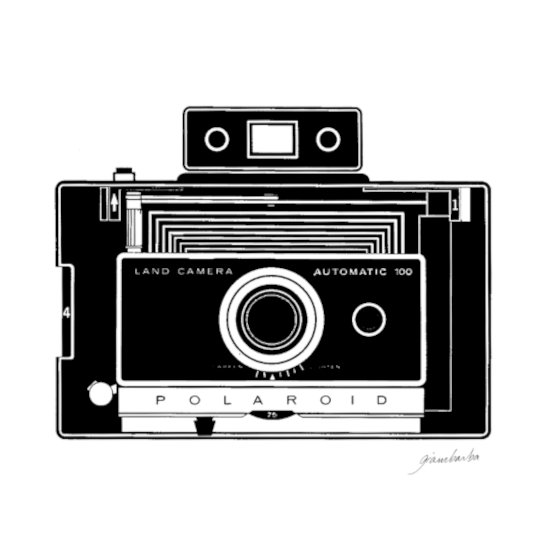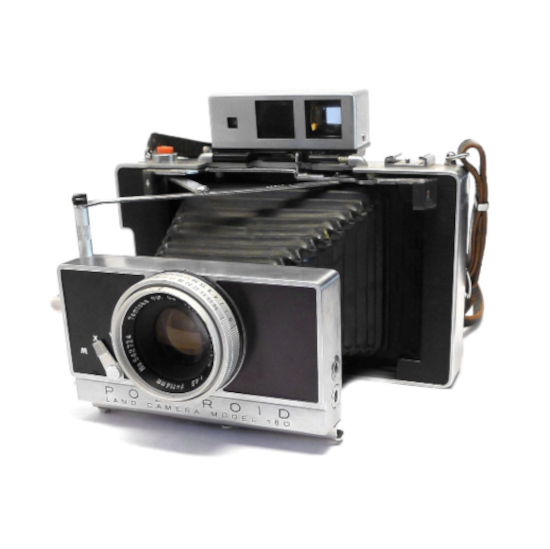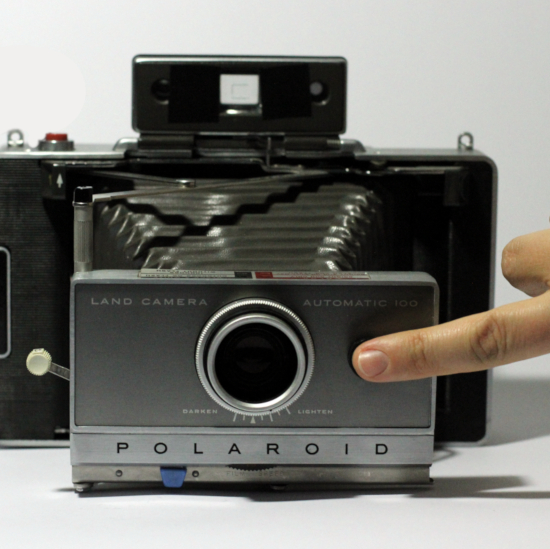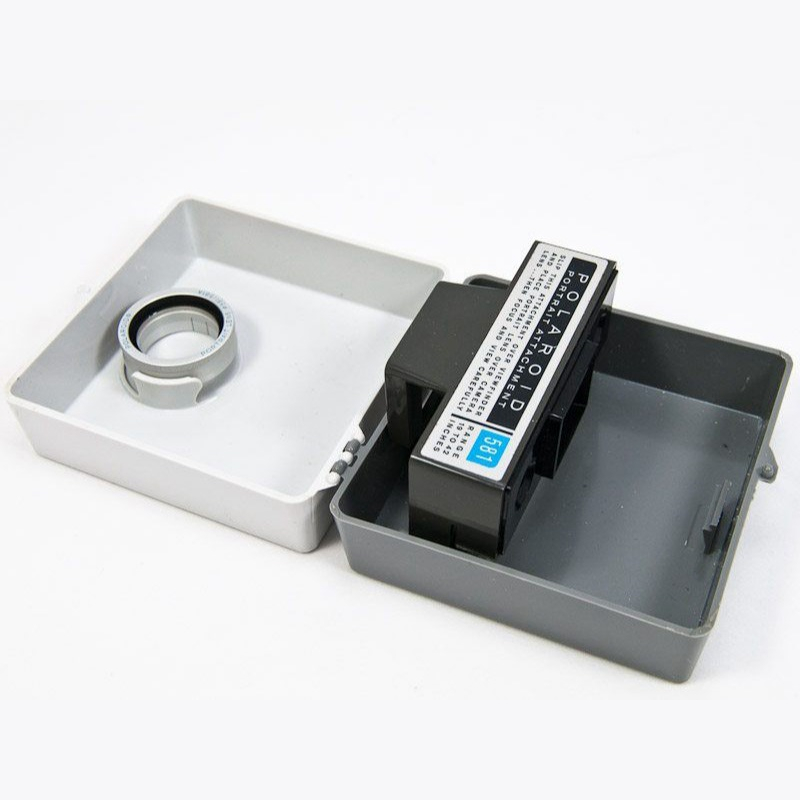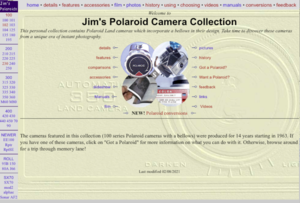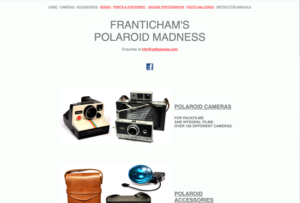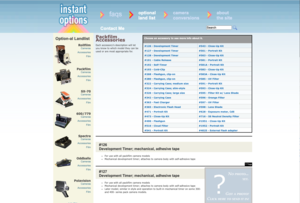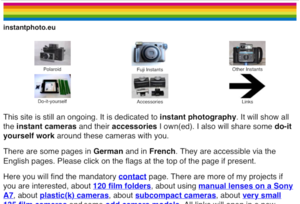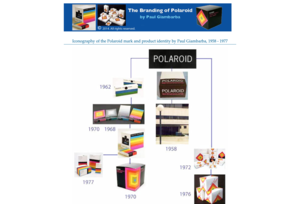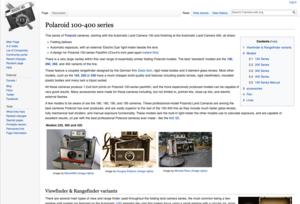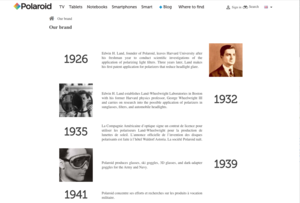Categories
Frequently asked questions
How can I tell if my camera works?
These cameras, now over 50 years old, have stood the test of time. To see if your camera works, start by looking at it's overall condition. If the camera body and cover are clean and free of damage, it's a good sign that it has been treated with care or lightly used.
Take a look at the bellows to see whether there are any holes or cracks in the folds. It's important that the bellows be light tight. Inspect the interior of the bellows for light leaks by opening the back of the camera, extending the bellows, and holding it up to the light. You can also place a flashlight inside the bellows and inspect the exterior of the bellows in a dark room. If there are any light leaks, your photos will be affected.
Next, check the battery compartment. If it contains an old battery and corrosion is present, you will need to clean it up with a damp cloth and hot water. Be sure that both the black and white wires are connected to the battery terminals and switch.
To find out whether the photoelectric cell is working, you will need to power up the camera with a fresh original battery or a battery adapter. Once connected, cover the electric eye (the small lens next to the camera lens) with your finger then press and hold down the shutter. You should hear two distinct clicks (open and close of the shutter). If you only hear one click, recheck the battery connection.
If the camera has a 'scene selector' switch and a thumb wheel film speed selector, run both controls through all their combinations (note that there's a heavy spring action behind the film speed control, that's not a defect). In particular, make sure the ASA numbers appear in the center of the 'window' and that the aperture diaphram appears centered in the lens.
Take a look at the lens and check for scratches and fungus or other deposits on the inside. Small 'cleaning' scratches probably won't cause a very noticeable degradation in image quality, but fungus and haze certainly may. Check the development rollers, if they're dirty and/or covered with developer goo, you can clean them up with a damp, lint-free cloth.
How can I modify the battery to AAA?
There are several ways to replace obsolete batteries found in these cameras. A relatively easy technique uses conventional AAA batteries. First of all, get a AAA battery holder (2 or 3 batteries, depending on whether your camera uses 3V or 4.5V (see table).
Remove the old battery holder by unscrewing the screw on the midle. On cameras with a plastic body you will need to break two plastic clips from the old holder to free up some space for the new holder.
Then, insert new AAA batteries, and put the snap on battery leads on the correct ends of the battery holder. Be sure the polarity is correct (white wire on positive, black wire on negative). Use electricians tape to secure the leads, stretching it while you wind it around the leads and battery holder.
If you have a soldering iron you can cut off the snap on terminals and solder the wires directly to the contacts of the AAA holder for a more sure connection.
Test to see whether the camera is operational by covering the electric eye (the small lens next to the camera lens) with your finger then pressing and holding down the shutter. You should hear two distinct clicks (open and close), so the battery is working OK.
What film can I use with my camera?
These cameras use 100 series pack film , also known as "peel-apart film". Print size is 8,5cm x 10,8cm (3 ¼ x 4 ¼ in.) and the image size is 7,3cm x 9,5cm (2.88 x 3.75 in.). Polaroid introduced this film in 1963 along with the first automatic Land camera . Unfortunately, Polaroid stopped producing this type of film in 2009.
However, since 2019, Oneinstant has been producing cartridges containing a single exposure (pack of three), in color and soon in black and white. Assembled by hand in Vienna and made with legacy stocks of negatives and positives from Polaroid along with new pods that contain the development chemicals.
Fujifilm also produced 100 type pack film until 2016: color FP-100C and black and white FP-3000B or FP-100B. It is still possible to find these Fuji instant film with an expiration date of 2019.
In 2009, The Impossible Project produced some "peel-apart" film with old Polaroid chemistries, in the form of special edition "Paul Giambarba", monochrome film: blue, sepia and chocolate.
If you want to try expired film, verify that the film has been stored flat at a constant temperature, such as in a fridge. Chemistry will typically dry up 10 years or more years after the expiration date, or sooner if not refrigerated. If you use expired film, it is advisable to slightly increase the exposure and let it develop longer. Try overexposing by 1 stop and overdevelop by 15-30 seconds, then adjust.
NEVER FREEZE THE FILM
Which cameras are better?
All models are easy to use and produce great results. But some models have a better lens and offer more features.
The cameras with a metal body have a tripod socket, glass optics with 3 elements and are able to use filters and portrait/close-up kits. Models: 100 / 101 / 240 / 250 / 350 / 355 / 360 / 450 / 455.
The models for advanced amateur and professional photography are the 180 / 190 and 195 which have a four element glass Tominon lens along with manual shutter and aperture controls.
Note that there is the very special model 185, given as gifts to friends and associates of Dr. Land. This is one of the most rare cameras produced by Polaroid, estimated production being around 50 units. It's distinguished by having a Mamiya lens and a needle light meter integrated into the viewfinder.
Two more recent limited editions, produced in 2000, also exist: model 195 NPC in the USA and the millennium 185 in Japan. These cameras have a different back than the 100-400 series and have a body made of machined anodized aluminum.
However, the best camera is undoubtedly the one inherited from a grandfather or the one you will find at a good price in a flea market.
Visit this page to know all the specifications and comparison.
How do I take care of my camera?
First of all, it is strongly recommended to protect the camera by closing the protective case when you are not using it. This will protect the lens, the viewfinder and the bellows from impacts and dust.
Clean the lens gently, breathe on the lens to moisten it, then wipe lightly with a clean, dry, absorbent cotton cloth. Also clean the lens over the eye cell, if there is dust, it may affect the automatic calculation of the exposure time.
If you are using peel apart film, keep the rollers clean. Lift up the red latch inside the door and swing out the rollers. Inspect them while turning, and clean with a damp cloth if dirty, then dry them. Push the rollers back into place. Never scrape the rollers with anything. Open the tab slot door and clean any residue and/or dirt.
Disconnect the battery if you don't use the camera for a long time, this will ensure that they will not corrode the battery terminals.
Can I convert the camera?
Yes, there is also the possibility of converting the camera to use Fuji Instax Wide film, using one photo directly inside the camera or changing the back of the camera.
Another possibility is converting the camera to use 35 or 120 mm roll film, which requires to develop the negatifs.
You can also use negative photographic paper without modifying the camera, negatifs which you have to develop in a darkroom.
Coming some tutoriels about the different conversions posssiblities.
Links
Referral websites about Land Cameras
Contributors
A big thanks to these passionate people!

Australia
Rachael Baez
Polaroid photographer artist

U.K.
Matt Smith
Surf culture, landscape and portrait

Netherlands
Lilian Wildeboer
Polaroid photographer artist

Italy
Alan Marcheselli
Polaroider, at My Instant Life Studio

Germany
Julia Beyer
Polaroid photographer from Essen

Germany
David Szubotics
The beauty of simplicity

United Kingdom
Hilary Clarke
Exploring a creative world

France
Vincent Radzinski
Nostalgic and elegant universe
Do you want to contribute?
The Knowledge center is always evolving. Contact us if you have any comments, questions, suggestions, or some information to contribute.
The knowledge center is a participatory place, here we join information and experience about the Polaroid Land camera. It's the opportunity to update knowledge about them and to make it affordable with a multilingual website and responsive on mobile.
